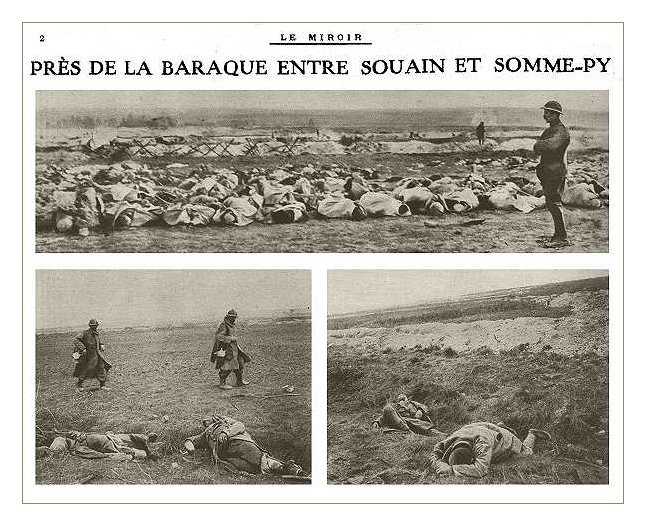


Photographing the Dead



Never a Dearth of Corpses

from the French newsmagazine 'Le Miroir' : German corpses on the battlefield
To be sure, during the Great War there was never a shortage of dead bodies, though how photographers and news editors went about publishing photographs of this main effect of warfare is not always easy to understand nor at times to comprehend. For us people of these modern times, many aspects of the Great War seem charmingly anachronistic and naive and while we like to believe that in the past society in general was more mannered and well-brought up, in some aspects this same society was quite callous about many things as well.
Contrary to modern myth, during the war itself, many many photographs of the dead were published in newsmagazines in all the warring countries. There are some general trends that are apparent however. British newseditors were apparently not so keen as their French allies to show great numbers of dead soldiers. An occasional corpse or two was quite sufficient for the staid Englishman, say a dead sniper who had got his just desserts or an unlucky Hun who had bit the dust.
French newseditors on the other hand seemed to positively delight in showing photographs of Boche corpses, the more the better. Many of the working class news magazines such as 'Le Miroir', 'J'ai Vu' or 'Sur le Vif' printed quite grisly scenes at times, trenches full of slain Germans or heaps of enemy bodies piled up for burial after a battle. Even illustrious magazines such as 'L'Illustration' had no qualms about showing photos of the enemy dead or of executed 'spies' and 'Le Pays de France' a solid and otherwise respectable magazine appears to have published more photos of dead German corpses than of their live British allies.
German magazines too published many photos of their enemy dead, though it must be said that German publications in general were far less bloodthirsty than their French counterparts.
But even if there are many instances to be found of photographs of the dead being published during the Great War , there was a certain code of conduct to be observed. Everything had to retain a certain semblance of good taste, even if in a somewhat macabre and grisly fashion. For instance it was not considered allowable to publish photos of maimed, burned or mutilated bodies, nor of body parts or of gaping or disfiguring wounds. Bodies had to be clothed and in a minimally normal posture as well, no twisted limbs or protruding bones to be seen.
To be sure, many photos of such things existed, but they were personal photos belonging to individual soldiers or maybe photos expressly taken for government and medical commissions or for hospital records, but never for publication. It was only after the war in a few anti-war books that such grim photographs were published. In the 1930s magazines also began to make much of so-called 'censored photos' from during the war, publishing special editions filled with such photographs, but upon closer examination most of these so-called censored photos had already been published during the war itself, even if only in obscure and less-known publications.
Below are links to several pages of photographs of the dead that were taken from war-time newsmagazines. This is only a small and maybe not even a representative selection.
* see also Hermann Rex : Unpublished Photos
To Illustrations